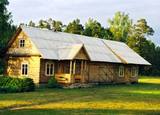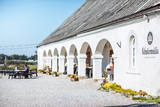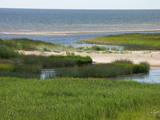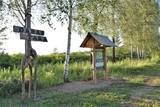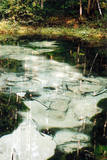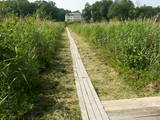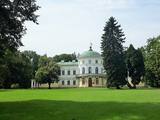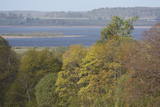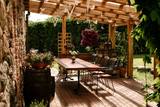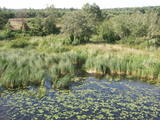| Nr | Name | Beschreibung |
|---|---|---|
|
Lauku sētas atrodas pie upītes, ciema nomalē, kas jau izsenis bijusi mājvieta biškopjiem. Vieta piemērota mierīgai atpūtai. Izglītojošas nodarbības ikvienam, kas ir ieinteresēts Dzūkijas kulinārajā mantojuma, amatniecībā un tradīcijās. Maizes cepšana, pīrāgi ar sēnēm, olu rotāšana ar vasku, pinumi no salmiem. Vakarēšana ar dzuku dziesmām un dejām. Tautastērpu izgatavošana gan bērniem, gan pieaugušajiem. |
||
|
Befindet sich im Nordteil von Valmiera. Das Herrenhaus des Landguts (im Stil des Neobarocks) wurde vom Herzog Peter August von Schleswig-Holstein-Sonderburg-Beck von 1764 bis1771 gebaut. Später gehörte es anderen verschiedenen Besitzern. Gemäß den heutzutage gefundenen Informationen kann man behaupten, dass das Herrenhaus des Landguts am Anfang des 20. Jahrhunderts ein einstöckiges Gebäude mit einem barockalen Türmchen und einem nebenstehenden zweistöckigen Korpus war. Das Haus diente als Sommer- und Jagdhaus. 1918 wurde das Gebäude verbrannt. Zwei Jahre später wurde im Landgut von Valmiermuiža ein Gefangenenlager eingerichtet. Später wurde den Anbau des Herrenhauses erneuert und als Schule verwendet. 1936 wurde im Gebäude ein Gefängnis eingerichtet, das während des Zweiten Weltkriegs als Haftanstalt der Gefangenen diente. Später wurde das Gebäude verbrannt und die Ruinen abgebaut worden sind. Bis heutzutage ist der Turm von Valmiermuiža erhalten geblieben. Die Deckenmalerei der Turmräume sowie der Park sind Kulturdenkmäler. Heutzutage ist neben dem historischen Ort die Brauerei von Valmiermuiža errichtet und das Landgut von Valmiermuiža hat die zweite Luft bekommen! |
||
|
Ainaži – Salacgrīva ist ein wichtiges Naturschutzgebiet für Riffe. Das Gebiet befindet sich gegenüber der Region Salacgrīva und die Fläche beträgt 7239 ha.
|
||
|
Kokneses dabas taka (5,65 km) ved gar Daugavas un Pērses krastiem un savieno Kokneses parku un Likteņdārzu. Pastaigā pa dabas taku var doties no jebkuras sevis izvēlētas vietas, kas vijas cauri Kokneses parkam. Takā izveidotas laipas, tiltiņi, informācijas stendi un norādes. |
||
|
Gegründet für den Schütz des von Wäldern reichtesten Gebietes Lituens und der mit der Bewirtschaftung des Gebietes verbundenen Volkstraditionen. |
||
|
Das Gotteshaus befindet sich in der Katedrāles Straße 1. Es ist im Jahr 1893 in den architektonischen Formen der hölzernen Kirchen von Nordrussland (Architekt Vladimirs Lunskis) gebaut worden und es ist das älteste Gotteshaus von Ķemeri. An der Kirche sind 97 im Ersten Weltkrieg gefallene russische Soldaten bestattet worden, denen im Jahr 1925 ein Denkmal – ein schwarzes Kreuz aus Marmor – enthüllt wurde. Unweit von der Kirche kann man einen Brüderfriedhof und ein Denkmal finden, die beide den im Zweiten Weltkrieg Gefallenen und den nach dem Krieg von Verletzungen Verstorbenen gewidmet sind. Laut Erzählungen wurde die Kirche ohne keinen einzigen Nagel gebaut. Die Kirche kann man während der Gottesdienste besuchen, aber die Besucher müssen geeignet angezogen sein! In anderer Zeit ist das Gebäude von außen zu besichtigen. |
||
|
Three little lakes can be found on the left bank of the Pirita River with many erupting “eyes” of streams, each with its own colour (bluish-green, white, dark). This puts together various colour combinations. These are often known as the most beautiful streams in Estonia. Some pump out as much as 20-30 litres of water per hour. It is said that the waters are good medical resources, particularly for the eyes. There are improvements in the area of tourists.
|
||
|
Ap 100 gadus veca priežu audze, ko iesēja pagājušā gadsimta sākumā. Sēklu materiāls bija nācis no kādas Vācijas (Darmštatē) sēklu tirdzniecības firmas. Mūsu klimatiskajos apstākļos priežu stumbri izauga līki un kroplīgi. Savdabīgā audze labi redzama no šosejas malas.
|
||
|
Alsunga wurde ursprünglich als Region Bandava schon 1230 in einem Vertrag des päpstlichen Gesandten mit dem Stamm der Kuren genannt. 1341 war Alsunga (deutsch: Alswangen, Kurisch: alšu vanga = Erlenlichtung) als „ein festes Haus“ benannt, 1372 begann der Bau einer aus Steinen gemauerten Burg in Form eines Vierecks, in dem der Fürst des Livonischen Ordens lebte, der dem Komtur von Kuldiga unterstand. Anfänglich wurde der östliche Korpus als Wohntrakt genutzt, der südliche als Wirschaftsflügel. Später, im 15. – 18. Jh. entstanden die Wehrtürme und die übrigen Teile des Schlosses. Die Ausmaße des Schlosses im Barockstil waren eindrucksvoll genug. Heute beherbergt es die Stadtverwaltung, ein Museum, ein Touristeninformtionszentrum und noch weitere Einrichtungen. |
||
|
Maršruts "Murjāņi - Līgatne" ved caur Gaujas senieleju ar devona smilšakmens atsegumiem, raksturīgo augu valsti un dzīvniekiem. Krastos sastopami Latvijā lielākie nogāžu un gravu meži ar liepām, ozoliem, gobām un ošiem. Upes līkumos palienē aug baltalkšņu un vīksnu audzes. Uz koku stumbriem atrodams plaušķērpis. Senieleja bagāta ar sausokņiem un kritalām, tāpēc Gaujas krastu mežos dzīvo visu Latvijā sastopamo dzeņu dzimtas sugu putni. Smilšainajās Gaujmalas pļavās un Gaujas vecupēs ir bagātīga bezmugurkaulnieku fauna. Upes krastos ir smilšakmens klintis ar čurkstu alām un zivju dzenīša ligzdām. Klinšu pakājē iztek avoti, kas uztur mikroklimatu ielejā. Gauja ir nozīmīga arī kā Latvijas lielākā lašupe. Maršruts ir daļēji marķēts un papildināts ar norādēm un informācijas stendiem. |
||
|
Der beste Platz, um sich das Schutzgebiet des Vīķi – Sumpfes, in dessen Zentrum sich der Lielauce – See befindet, anzuschauen, ist die Lielauce – Burg, wo ein hölzerner Plankenweg beginnt. Der Pfad leitet den Besucher durch die sumpfigen Ufer des Lielauce – Sees zu einem offenen Teil des Sees, wo man Boot fahren kann. Der Sumpf selbst befindet sich im südöstlichen Teil des Sees. Das Schutzgebiet wurde eingerichtet, um die Biotope und Arten in dem Gebiet zu schützen.
|
||
|
Gäste werden herzlich erwartet in die im Jahr 1887 erbaute Riegenstube Ketta. Erfahren sie mehr über die die Schmiedarbeit und wie macht man Holzkohle, was ist eine Riegenstube, wie heizt man Riegenofen, was ist Dreschen und Absieben. |
||
|
Das Gut Baisogala zählt zu den ältesten in Litauen und wurde als königliche Domäne bezeichnet, das es dem litauischen Großfürsten gehörte. Das prächtige Herrenhaus stammt in seiner heutigen Form aus der Mitte des 19. Jahrhunderts im Stil des Spätklassizismus (Empire). Der 12 ha große Landschaftspark wurde in der ersten Hälfte des 19. Jh. angelegt. Zur Stadt hin führt eine Kastanienallee. Ab dem Haupttor führt die gewundene Allee zwischen zwei Teichen hindurch über eine Brücke mit Löwenfiguren. Hinter dem Herrenhaus beschatten Bäume verschiedenster Arten die gewundenen Wege und schmale Pfade. Beidseitig der Hauptallee befindet sich je ein Teich. Ein dritter Teich mit Insel findet sich am anderen Ende des Parks. |
||
|
Ein ausgezeichneter Sandsteinaufschluss, der sich am rechten Uferhang der Gauja versteckt und eine Höhe von 15 m erreicht. Der Aufschluss wurde von einer wilden Bienenart durchlöchert, die kleine Höhlen in den Sandstein gebohrt haben, in denen sich ihre Larven entwickeln. Es wurde ein gut ausgestatteter Pfad mit Treppen angelegt. Die Objekte liegen im Nationalpark Gauja.
|
||
|
In der Stube finden Veranstaltungen zur Erholung und Freizeitgestaltung für Menschen verschiedenen Alters statt. Kreative Workshops und verschiedene Vorlesungen sind auf Familien ausgerichtet, um deren Kreativität zu fördern. Der Vorgang des Steigenlassens von Drachens wird für Kinder ritualisiert, gewissermaßen lassen die Kinder ihren Traum in den Himmel steigen. Maximale Zahl von Personen pro Veranstaltung. |
||
|
Nature restricted area includes eastern side of the lake with Lanupe River and North-east and South-east coastal areas. Restricted area has been established for protection of birds and floodplain meadows of the lake. To see the nature restricted area visitors do not have to enter it. There are great view points with wind generators of Grobina on the background from the road Vecpils – Rava – Aistere. Coastal areas which are not included in the restricted area are perfectly suitable for bird watching. There is located the smallest city by its population in Latvia to the South from the lake.
|
||
|
Das unterirdische Museum ist die spannendste Attraktion im Grubenpark-Museum von Kohtla. Machen sie eine unvergessliche Tour durch die unterirdischen Arbeitsplätze der Grubenarbeiter, besuchen sie das Sprengstofflager, fähren sie mit dem echten Bergbau-Zug und erfahren sie mehr über Bergbautechnologie. In der unterirdischen Kantine haben sie die Möglichkeit ein echtes Grubenarbeiter-Dinner zu geniessen. |
||
|
Diese Tour bietet Ihnen die Möglichkeit, das Beste vom Winter in Lettland zu erleben. Sie beginnt in der regen Hauptstadt Riga mit ihrem Weihnachtsmarkt, Verzierungen, Einkaufsmöglichkeiten, vielen Kulturveranstaltungen und Museen, sowie mit der zauberhaften Altstadt. Danach führt die Tour auf dem Land, wo man auf Skipisten und an Schlittenhängen die Winterfreuden genießen kann. Nach einem aktiven Tag ist die Zeit gekommen, sich in einem Spa Hotel verwöhnen zu lassen, wo man auch die gesunden und einzigartigen Rituale der lettischen Sauna ausprobieren kann. Besuchen Sie die Ruinen der mittelalterlichen Burg von Sigulda, die Burg Turaida und probieren Sie den hausgemachten Wein im Landgut von Krimulda. Auf den Naturpfaden des Naturparks Ligatne können Sie sehr leicht die einheimischen wilden Tiere, z.B. Wölfe, Bären, Elche und andere beobachten. Danach können Sie auf einem unweit gelegenen Hof eine Fahrt mit einem Pferdeschlitten genießen. |
||
|
Der Hof bietet seinen Gästen Führungen durch die Brauerei des Gutes Butautai, Fahrradtouren, Spaß im Wasser und Angeln im Fluss Levuo sowie Gerichte mit Hopfen. |
||
|
Dieses Gebiet wird regelmäßig überflutet, wenn der Fluß Lielupe über seine Ufer tritt. Diese Auenwiesen sind wichtig für Vögel. Das Gebiet kann von der Straße Rīga-Liepāja und von der Straße nach Kalnciems aus, die daran entlang führen, betrachtet werden.
|
||
